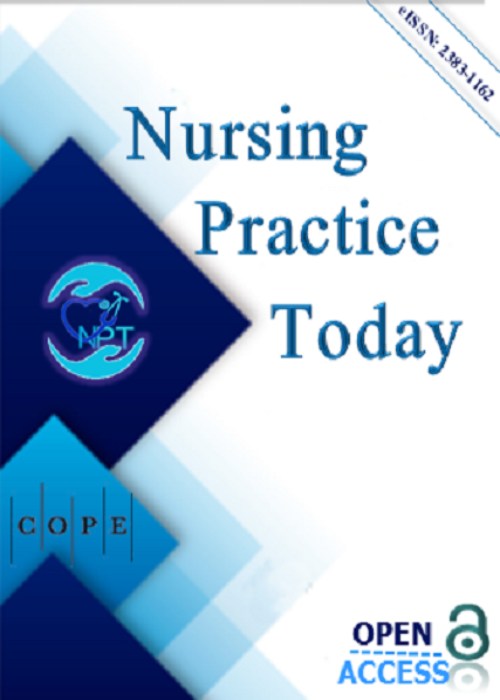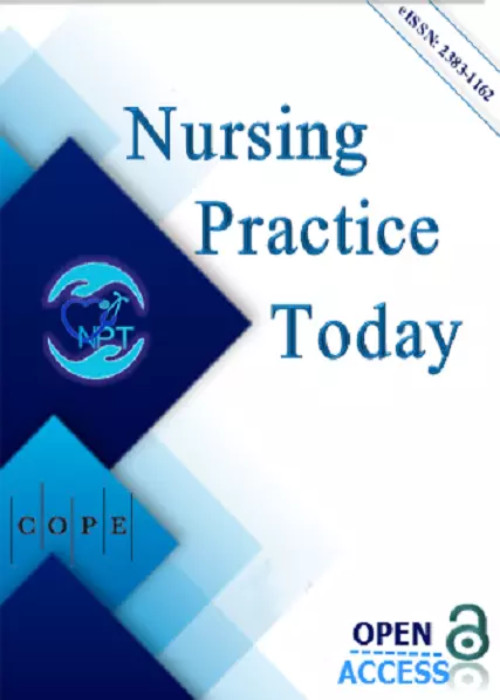فهرست مطالب

Nursing Practice Today
Volume:10 Issue: 1, Winter 2023
- تاریخ انتشار: 1401/12/27
- تعداد عناوین: 10
-
-
Pages 4-6Introduction
Medicines are the most widely used interventions in health care, and adverse drug reactions alone are responsible for 5-10% of hospitalizations in elderly patients. Carbamazepine is an anticonvulsant drug, and skin rash is one of its rare symptoms. It requires immediate medical attention and is sometimes life-threatening.
Case Report:
This case report is about a 72-year-old woman who witnessed the interaction of rivaroxaban and carbamazepine and the side effects of carbamazepine simultaneously.
ConclusionPatient participation and patient-centered tools are needed to promote patient safety.
Keywords: medication safety, patient safety, carbamazepine, patient participation -
Pages 7-12Background & Aim
To meet the changing global population needs and demands of patient care, healthcare systems worldwide are under restructuring and transformation. Advanced practice nursing has been adopted in many developed countries to meet pressing issues like workforce shortage and equitable distribution of competent healthcare professionals. However, Nigeria is yet to take advantage of this initiative despite being seriously affected by these issues. This article documents the need for and prospects of advanced practice nursing in Nigeria.
Methods & Materials:
A descriptive theoretical and empirical literature analysis was done to explain the impact of advanced practice nursing in advancing the Nigerian health system.
ResultsThe expertise and capacity of the nursing workforce, especially its numerical strength, can be utilized to improve Nigeria’s health system and achieve the global goal of making quality healthcare accessible and available to all, thereby achieving universal health coverage.
ConclusionElevating the competencies of nurses through investments in advanced practice nursing will make primary healthcare available to Nigerians living in poverty, rural dwellers, youth, and children, thereby reducing the burden of diseases and improving health promotion and disease prevention.
Keywords: advanced practice nursing, healthcare delivery, Nigeria, nurses -
Pages 13-22Background & Aim
Mutuality has been defined as being placed between paternalism and autonomy on the spectrum of patient engagement in care, which involves a shared experience and reciprocity between involved parties. Mutuality is foundational in creating growth and fostering relationships to improve health outcomes and address health disparities. This paper aims to examine and compare measurement instruments that measure the concept of mutuality.
Methods & MaterialsA systematic search was conducted to examine how mutuality has been measured. Eight studies were included in the analysis.
ResultsThe Mutuality Scale, the Mutuality and Interpersonal Sensitivity Scale, the Friendship Quality Questionnaire, and the Connection-Disconnection Scale were discovered. Theoretical frameworks and psychometrics were analyzed.
ConclusionMutuality has been applied in a variety of contexts and proves to be an important concept in understanding the needs and perspectives of culturally diverse communities. selection of a measurement instrument is going to be driven by a theoretical framework and definitions of mutuality. All identified instruments demonstrated strengths and weaknesses. Therefore, it is important to weigh these strengths and weaknesses when selecting a measurement instrument in clinical practice or research.
Keywords: mutuality, communication, measurement -
Pages 23-31Background & Aim
The perceived implicit rationing of nursing care is a tool for evaluating the rationing of nursing care. This tool has been used and psychometrically validated previously in different countries but never in Indonesia. This study aimed to assess the psychometric properties of the Indonesian version of the perceived implicit rationing of nursing care.
Methods & MaterialsA descriptive cross-sectional design was chosen to investigate psychometric properties of the perceived implicit rationing of nursing care. The data collection period was duringMay 2021. Statistical analyses were performed using Partial Least Square-Structural Equation Models (PLS-SEM) on the SPSS software with the assistance of the Smart PLS-3 program. A multivariate analysis was conducted to assess construct validity. Cronbach’s alpha coefficient was used to evaluate instrument reliability.
ResultsOuter loading for the entire instrument was > 0.7. Cronbach’s alpha for documentation-supervision= 0.994; communication= 0.931; and implementation of the prescribed treatment plan= 0.984. Using both statistical methods when evaluating the perceived implicit rationing of nursing care, in the confirmation that the tool is valid and reliable.
ConclusionThis version of the perceived implicit rationing of the nursing care instrument showed acceptable psychometric properties for use as an assessment instrument in an Indonesian-speaking country.
Keywords: psychometric properties, rationing of care, nursing care, nurses -
Pages 32-43Background & Aim
Many patients with dementia experience sleep-related issues. However, the nursing practices that address those issues are unclear. Therefore, to develop a self-assessment scale of nursing practices to improve sleep quality in patients with dementia taking sleep medication and confirm its validity and reliability.
Methods & MaterialsIn this mixed-methods study, qualitative research was conducted by interviewing six expert-level nurses with a wealth of experience in caring for patients with dementia; then, quantitative survey questions were administered. The preliminary scale was created and evaluated its face validity. This quantitative study was conducted using questionnaire surveys among nurses with psychiatric ward experience employed at dementia treatment centers across Japan. Data from 525 nurses were used to verify the validity and reliability of the scale.
ResultsExploratory factor analysis resulted in a three-factor, 16-item scale. Criterion validity was confirmed by calculating correlation coefficients with existing scales (the self-evaluation scale of oriented problem-solving behavior in nursing practice) as external criteria (r= 0.574, p< .05). The sum of scale scores and Cronbach’s α coefficients for the three factors all exceeded 0.7.
ConclusionThe development of this scale will improve the quality of nursing practice for patients with dementia who take sleeping pills. Additionally, it provides foundational research on nursing practice for the appropriate use of medications, as it offers evidence that nurses participate in drug treatment.
Keywords: dementia, sleep aids, nursing evaluation research -
Pages 44-52Background & Aim
Foot ulceration and amputation have increased significantly among Chinese patients with type 2 diabetes mellitus. Proper foot care behavior is an important strategy for reducing the risk of diabetes-related foot issues. The current study aimed to assess foot care behavior and its influencing factors, including self-efficacy, foot care knowledge, and social support, among patients with type 2 diabetes mellitus who have a high-risk diabetic foot in Wenzhou, China.
Methods & MaterialsThis research used a correlational predictive design. In total, 107 participants who were eligible for the study were randomly selected. Five self-reported questionnaires, including the demographic questionnaire, Diabetes Self-Efficacy Scale, Foot Care Knowledge questionnaire, Perceived Social Support Scale, and Chinese version of the Nottingham Assessment of Functional Footcare, were utilized. Descriptive statistical and standard multiple linear regression analyses were performed to evaluate data.
ResultsApproximately 90.7% of participants had poorly controlled diabetes (HbA1c≥ 7%), and 95.3% presented with foot deformities. Further, 51.4% of participants reported moderate foot care behavior, and 42.1% had poor foot care behavior. The multiple regression analysis revealed that self-efficacy, foot care knowledge, and social support significantly explained 31.1 % of the variability in foot care behavior. However, self-efficacy could predict foot care behavior (β= .490, p< .001).
ConclusionIt is important to improve foot care behavior among patients with type 2 diabetes who have a high-risk diabetic foot. Nursing interventions to enhance foot care behavior should focus on improving self-efficacy and providing foot care education regularly.
Keywords: type 2 diabetes mellitus, diabetic foot, foot care behavior, foot care knowledge, self-efficacy -
Pages 53-61Background & Aim
Although the nursing process can help ensure the quality of nursing care, some nurses do not implement it in patient care. This study assessed nurses' knowledge and use of the nursing process in two major hospitals in Fako.
Methods & MaterialsA cross-sectional design with a purposive sample of 101 nurses was used. In addition, 310 randomly selected files of hospitalized patients were examined for the presence and effective use of a nursing care plan. A questionnaire was used to collect data on knowledge and use of the nursing process among nurses, while a checklist was used to audit hospital files for adequate use of the nursing care plan. Data were analyzed using both descriptive and inferential statistics, with the aid of SPSS version 20, with all statistics at Alpha=0.05.
ResultsThe majority (85.1%) of participants had a mean knowledge score of 8.5/10 (1.06). There was a statistically significant association between nurses' knowledge and gender (χ2=17.998, P=0.003), age group (χ2=49.809, P=0.000), qualification (χ2=65.989, P=0.003) and duration of work experience (χ2=28.158, P=0.021). Most nurses (62.6%) reported using the nursing process only sometimes during patient care. There was a statistically significant association between nurses' age (χ2=9.723, P=0.049), qualification (χ2=34.67, P=0.000), and use of the nursing process. Only 42 files had a complete nursing care plan. Increased workload and nursing shortages were found to hinder the use of the nursing process.
ConclusionNurses had good knowledge of the nursing process but did not effectively use it. Thus, the quality of care received by patients in these hospitals is questionable. Strategies to improve the use of the nursing process are needed for effective nursing care.
Keywords: patient care planning, nursing process, knowledge, practice, Cameroon -
Pages 62-70Background & Aim
Volunteers’ perceptions may affect their future decisions to participate in crisis intervention. Few studies in Iran have been conducted to examine the experiences of medical personnel who volunteered during the COVID-19 pandemic. This qualitative study describes the experiences of medical volunteers during COVID-19 in Iran.
Methods& MaterialsAtotal 17 healthcare volunteers who worked in COVID-19 hospital wards were recruited using purposive sampling. All participants were recruited in the current study from the hospitals affiliated with the Tehran University of Medical Sciences if they expressed their willingness to participate and had at least two months experience of working as healthcare volunteers in COVID-19 wads. In-depth video-call semi-structured interviews were conducted from August to November 2020. The data were analyzed using the qualitative thematic analysis method.
ResultsOne main theme “from nuisance to helpful assistants” and four sub-themes including the “feeling of inefficiency”, “negligent managing”, “situation orientation”, and “transformation for integrity” emerged from the data.
ConclusionDespite experiencing challenges, the volunteers and hospital staff tried to change their approaches to joint collaboration by improving their capabilities for situation awareness and creating integrity. These findings provide policymakers with a better understanding of health volunteers' challenges in hospitals during crises.
Keywords: COVID-19, hospital volunteers, perception, Iran, qualitative research -
Pages 71-80Background & Aim
The fact that the nursing profession is seen as a female profession deepens gender discrimination in the nursing profession. This research aimed to develop a valid and reliable measurement tool to determine the gender attitudes of nursing students towards the nursing profession and study the psychometric properties thereof.
Methods & MaterialsThe study is methodological research. The research was conducted with 238 nursing students at a public university in Türkiye.
ResultsExploratory factor analysis reduced the total number of items from 41 to 10. 10 items categorized under three factors were determined to explain 57.11% of the total variance. The total Cronbach Alpha value of the scale is .62. The scale consists of 3 factors entitled “Male Gender Role”, “Professional Stereotypes,” and “Gender Discrimination”, which further include a total of 10 items.
ConclusionThe scale is a valid and reliable measurement tool that can be used to determine the gender attitudes of nursing students toward the nursing profession.
Keywords: nursing students, gender, attitude, validity, reliability


